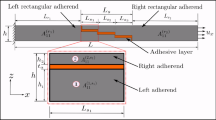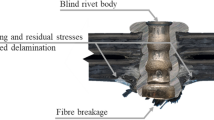Abstract
Debonding of fiber/matrix interfaces, kinking on debonded matrix surfaces, and tearing of interfiber ligaments are three major failure modes in micro-scales often observed in the failure experiments of Fiber Reinforced Composites (FRC) under extreme transverse tensile loadings. Numerical simulations on these complex failure processes at micro-scales are critical for designing new FRC materials. However, it is difficult to simultaneously simulate all these failure modes especially for cases where bulk matrix materials are ductile and undergo large plastic deformation. To overcome this difficulty, we adopt an innovative DG-based interface-oriented finite element technique that is able to handle all three failure modes. In this paper, using this numerical technique, we successfully simulate a complete failure process characterized by all three fracture modes for a composite structure containing two fibers embedded in a ductile bulk matrix. Furthermore, the kinking of debonded matrix surfaces predicted from simulations agrees well with the experimental results. Finally, we have studied the impact of variation in the thickness of interfiber ligaments on the failure behaviors of FRC materials. By running four cases with varied ligament thicknesses, we have identified a beam-like mixed bending/shearing failure mode for the tearing of interfiber ligaments and the shearing influence on the failure may increase following the increase in ligament thickness.










Similar content being viewed by others
References
Benson J (2010) Continuum models of ductile fracture: a review. Int J Damage Mech 19:3–52
Boyce BL, Kramer SLB, Fang HE, Cordova TE, Neilsen MK, Dion K, Kaczmarowski AK, Karasz E, Xue L, Gross AJ, Ghahremaninezhad A, Ravi-Chandar K, Lin S-P, Chi S-W, Chen JS, Yreux E, Rter M, Qian D, Zhou Z, Bhamare S, O’Connor DT, Tang S, Elkhodary KI, Zhao J, Hochhalter JD, Cerrone AR, Ingraffea AR, Wawrzynek PA, Carter BJ, Emery JM, Veilleux MG, Yang P, Gan Y, Zhang X, Chen Z, Madenci E, Kilic B, Zhang T, Fang E, Liu P, Lua J, Nahshon K, Miraglia M, Cruce J, DeFrese R, Moyer ET, Brinckmann S, Quinkert L, Pack K, Luo M, Wierzbicki T (2014) The Sandia Fracture Challenge: blind round robin predictions of ductile tearing. Int J Fract 186:5–68
Canal LP, Gonzalez C, Segurado J, LLorca J (2012) Intraply fracture of fibre reinforced composites: microscopic mechanisms and modelling. Compos Sci Technol 72:1223–1232
Carol I, Lopez CM, Roa O (2001) Micromechanical analysis of quasi-brittle materials using fracture-based interface elements. Int J Numer Methods Eng 52:193–215
Chandra N, Li H, Shet C, Ghonem H (2002) Some issues in the application of cohesive zone models for metal ceramic interfaces. Int J Solids Struct 39:2827–2855
Chao R, Laws N (1997) The fiber-matrix interface crack. J Appl Mech 64:992–999
Dawson CN, Sun S, Wheeler MF (2004) Compatible algorithms for coupled flow and transport. Comput Methods Appl Methods Eng 193:2565–2580
Fiedler B, Hojo M, Ochiai S, Schulte K, Ando M (2001) Failure behaviour of an epoxy matrix under different kinds of static loading. Compos Sci Technol 61:1615–1624
Fitoussi J, Guo G, Baptiste D (1996) Determination of a tridimensional failure criterion at the fibre/matrix interface of an organic-matrix/discontinuous-reinforcement composite. Compos Sci Technol 56:755–60
Gao X, Kim J (2006) Modeling of ductile fracture: significance of void coalescence. Int J Solids Struct 43:6277–6293
Gross AJ, Ravi-Chandar K (2014) Prediction of ductile failure using a local strain-to-failure criterion. Int J Fract 186:69–91
Hinton MJ, Soden PD, Kaddour AS (2002) WorldWide failure exercise on failure predictions in composites. Compos Sci Technol 62:12–13
Hutchinson JW, Suo Z (1992) Mixed mode cracking in layered materials. Adv Appl Mech 29:63–191
Johnson GR, Cook WH (1985) Fracture characteristics of three metals subjected to various strains, strain rates, temperatures and pressures. Eng Fract Mech 21:31–48
Lassance D, Fabregue D, Delannay F, Pardoen T (2007) Micromechanics of room and high temperaturefracture in 6xxx Al alloys. Prog Mater Sci 52:62–129
Lee BJ, Mear M (1999) Stress concentration induced by an elastic spheroidal particle in a plastically deforming solid. J Mech Phys Solids 47:1301–36
Legarth BN, Niordson CF, Ghonem H (2010) Debonding failure and size effects in micro-reinforced composites. Int J Plast 26:149–165
Li S, Ghosh S (2007) Modeling interfacial debonding and matrix cracking in fiber reinforced composites by the extended Voronoi cell FEM. Finite Elem Anal Des 43:397–410
Li Z, Ghosh S, Getinet N, OBrien DJ (2016) Micromechanical modelling of the transverse damage behaviour in fibre reinforced composites. Compos Sci Technol 71:37–52
Liu R, Liu Z (2018) An implicit discontinuous Galerkin finite element framework for modeling fracture failure of ductile materials undergoing finite plastic deformation. Int J Numer Methods Biomed Eng 115:1383–1409
Liu R, Wheeler MF, Dawson C (2009) A three-dimensional nodal-based implementation of a family of discontinuous Galerkin methods for elasticity. Comput Struct 87:141–150
Liu R, Wheeler MF, Dawson CN, Dean R (2010) A fast convergent rate preserving discontinuous Galerkin framework for rate-independent plasticity problems. Comput Methods Appl Mech Eng 199:3213–3226
Liu R, Wheeler MF, Yotov I (2012) On the spatial formulation of discontinuous Galerkin methods for finite elastoplasticity. Comput Methods Appl Mech Eng 253:219–236
Liu R, Mostafa A, Liu Z (2018) Modeling of structural failure of zircaloy claddings induced by multiple hydride cracks. Int J Fract 213:171–191
Melro A, Camanho P, Pires F, Pinho S (2013) Micromechanical analysis of polymer composites reinforced by unidirectional fibres: part I–constitutive modelling. Int J Solids Struct 50:1897–1905
Nguyen VP (2004) Discontinuous Galerkin/extrinsic cohesive zone modeling: implementation caveats and applications in computational fracture mechanics. Eng Fract Mech 128:37–68
Pardoen T, Hutchinson JW (2000) An extended model for void growth and coalescence. J Mech Phys Solids 48:2467–2512
Pardoen T, Hutchinson JW (2003) Micromechanics-based model for trends in toughness of ductile metals. Acta Mater 51:133–148
Paris F, Correa E, Canas J (2003) Micromechanical view of failure of the matrix in fibrous composite materials. Compos Sci Technol 63:1041–1052
Paris F, Correa E, Mantic V (2007) Kinking of transversal interface cracks between fiber and matrix. J Appl Mech 74:703–716
Park K, Paulino GH (2011) Cohesive zone models: a critical review of traction-separation relationships across fracture surfaces. Appl Mech Rev 64:060802
Pinho S, Iannucci L, Robinson P (2006) Physically based failure models and criteria for laminated fibre-reinforced composites with emphasis on fibre kinking. Part II: Fe implementation. Int J Solids Struct 37:766–777
Pinho S, Iannucci L, Robinson P (2013) Micromechanical analysis of polymer composites reinforced by unidirectional fibres: part II—micromechanical analyses. Int J Solids Struct 37:1906–1915
Prasad PBN, Simha RY (1997) Interface crack around circular inclusion: SIF, kinking, debonding energetics. Eng Fract Mech 70:285–307
Prechtel M, Leugering G, Steinmann P, Stingl M (2011) Towards optimization of crack resistance of composite materials by adjustment of fiber shapes. Eng Fract Mech 78:944–960
Puck A, Schrmann H (2002) Failure analysis of FRP laminates by means of physically based phenomenological models. Compos Sci Technol 62:1633–1662
Radovitzky R, Seagraves A, Tupek M, Noels L (2011) A scalable 3D fracture and fragmentation algorithm based on a hybrid, discontinuous Galerkin, cohesive element method. Comput Methods Appl Mech Eng 200:326–344
Raghava R, Caddell RM, Yeh GSY (1973) The macroscopic yield behaviour of polymers. J Mater Sci 8:225–232
Rice JR, Suo Z, Wang J (1990) Mechanics and thermodynamics of brittle interfacial failure in bimaterial systems. Acta-Scripta Metall Proc Ser 4:269–294
Soden P, Kaddour A, Hinton MJ (2004) Recommendations for designers and researchers resulting from the world-wide failure exercise. Compos Sci Technol 64:589–604
Tana W, Nayac F, Yang L, Chang T, Falzon BG, Zhan L, Molina-Aldareguia JM, Gonzalez C, Llorca J (2018) The role of interfacial properties on the intralaminar and interlaminar damage behaviour of unidirectional composite laminates: Experimental characterization and multiscale modelling. Compos Part B Eng 138:206–221
Truster TJ, Masud A (2013) A discontinuous/continuous Galerkin method for modeling of interphase damage in fibrous composite systems. Comput Mech 52:499–514
Tvergaard V, Hutchinson JW (2002) Two mechanisms of ductile fracture: void by void growth versus multiple void interaction. Int J Solids Struct 39:3581–3597
Vajari A, Martyniuk K, Sorensen, Legarth B (2013) Experimental and numerical study of the micro-mechanical failure in composites. In: Proceedings of the 19th international conference on composite materials, Canadian Association for Composite Structures and Materials, pp 5853–5863
Varna J, Berglund LA, Ericson ML (1997) Transverse single-fibre test for interfacial debonding in composites: 2. Compos Part A Appl Sci Manuf 28:317–326
Vaughan T, McCarthy CT (2011) Micromechanical modelling of the transverse damage behaviour in fibre reinforced composites. Compos Sci Technol 71:388–396
Wu L, Tjahjanto D, Becker G, Makradi A, Jerusalem A, Noels L (2013) A micro-meso-model of intra-laminar fracture in fiber-reinforced composites based on a discontinuous Galerkin/cohesive zone method. Eng Fract Mech 104:162–183
Zhandarov SF, Pisanovab EV (1997) The local bond strength and its determination by fragmentation and pull-out tests. Compos Sci Technol 57:957–64
Zhang H, Ericson ML, Varna J, Berglund LA (1997) Transverse single-fibre test for interfacial debonding in composites: 1. Compos Part A Appl Sci Manuf 28:309–315
Acknowledgements
The first author, Ruijie Liu acknowledges funding support for this research from NSF Computational Mathematics Program under Award number: DMS-1911325.
Author information
Authors and Affiliations
Corresponding author
Additional information
Publisher's Note
Springer Nature remains neutral with regard to jurisdictional claims in published maps and institutional affiliations.
Rights and permissions
About this article
Cite this article
Liu, R., Mostafa, A. Numerical study of interfiber ligament failure of composites wth ductile bulk matrices. Int J Fract 225, 101–114 (2020). https://doi.org/10.1007/s10704-020-00473-z
Received:
Accepted:
Published:
Issue Date:
DOI: https://doi.org/10.1007/s10704-020-00473-z




